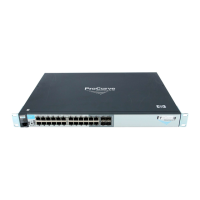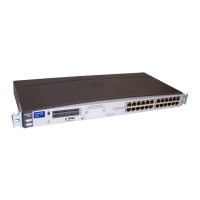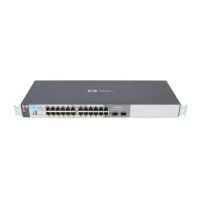Port Traffic Controls
Rate-Limiting
If at a given moment:
■ Inbound ICMP traffic on port “X” is using 1% of the port’s bandwidth, and
■ Inbound traffic of all types on port “X” demands 61% of the ports’s
bandwidth,
then all inbound traffic above 55% of the port’s bandwidth, including any
additional ICMP traffic, will be dropped as long as all inbound traffic combined
on the port demands 55% or more of the port’s bandwidth.
Displaying the Current ICMP Rate-Limit Configuration
The show rate-limit icmp command displays the per-interface ICMP rate-limit
configuration in the running-config file.
Syntax: show rate-limit icmp [ port-list ]
Without [ port-list ], this command lists the ICMP rate-limit
configuration for all ports on the switch. With [ port-list ], this
command lists the rate-limit configuration for the specified
interface(s). This command operates the same way in any
CLI context.
For example, if you wanted to view the rate-limiting configuration on the first
six ports in the module in slot “B”:
Ports B2-B5 are configured with an ICMP
rate limit of 1%. (Ports B1 and B6 are not
configured for ICMP rate-limiting.)
Figure 13-4. Example of Listing the Rate-Limit Configuration
The show running command displays the currently applied setting for any
interfaces in the switch configured for all traffic rate-limiting and ICMP
rate-limiting. The show config command displays this information for the
configuration currently stored in the startup-config file. (Note that configura-
tion changes performed with the CLI, but not followed by a write mem
command do not appear in the startup-config file.)
13-13

